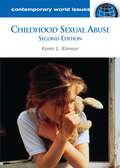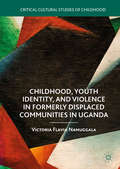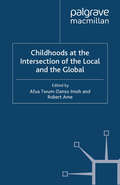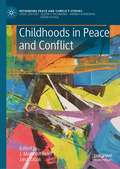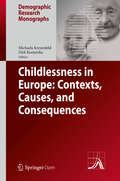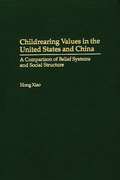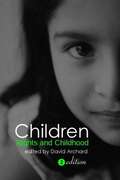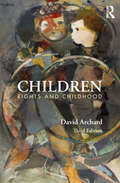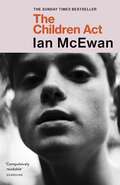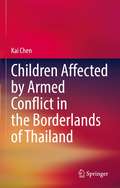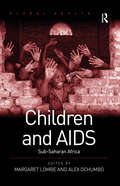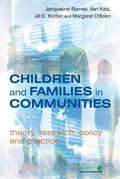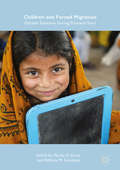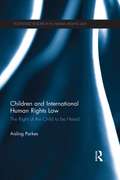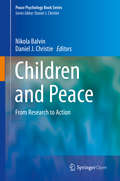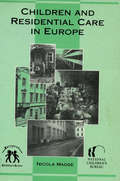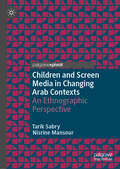- Table View
- List View
Childhood Sexual Abuse: A Reference Handbook (Contemporary World Issues)
by Karen L. KinnearThis work is an important new edition of a classic study—one of the few exhaustive examinations of childhood sexual abuse available—with 40 percent new material.Even though it is as old as human history, child sexual abuse has generally remained a dark and well-hidden secret. Only in the last few decades has it become a topic of open public debate and scientific research, and we still have more questions than answers. How often are accusations of sexual abuse legitimate, and how often are they the result of false memories? Can sexual offenders be cured, or will they ultimately re-offend?These are only a few of the difficult questions this volume seeks to answer. Childhood Sexual Abuse: A Reference Handbook explores the many ways we define child sexual abuse in the United States and in different parts of the world and how those differences are represented in U.S. and international laws. It summarizes what we know about how to intervene, treat, and prevent childhood sexual abuse effectively and tells the stories of individuals who have had a dramatic effect on the handling of childhood sexual abuse. For students, social workers, teachers, policymakers, parents, and concerned citizens, this work offers a one-stop, multifaceted discussion of one of the major issues facing children and their families.
Childhood, Youth Identity, and Violence in Formerly Displaced Communities in Uganda (Critical Cultural Studies of Childhood)
by Victoria Flavia NamuggalaThis volume provides a critical assessment of the mainstream western childhood constructions and their impact to the developing world. Using African feminist and indigenous epistemological frameworks, the volume decolonizes the understanding of childhood, children, and youth. Specifically, the volume presents Global South contestations to mainstream western constructions by exploring alternative notions to standardized universal understanding of childhood. The author further deliberates childhood as a human right, exploring how armed violence hinders realization of such rights assessing humanitarian assistance during armed violence. Besides childhood, the volume explores the complex intersectional nature of youthhood and its cultural relevance to formerly displaced communities and how this manifests in access to and use of humanitarian assistance.
Childhood, Youth Identity, and Violence in Formerly Displaced Communities in Uganda (Critical Cultural Studies of Childhood)
by Victoria Flavia NamuggalaThis volume provides a critical assessment of the mainstream western childhood constructions and their impact to the developing world. Using African feminist and indigenous epistemological frameworks, the volume decolonizes the understanding of childhood, children, and youth. Specifically, the volume presents Global South contestations to mainstream western constructions by exploring alternative notions to standardized universal understanding of childhood. The author further deliberates childhood as a human right, exploring how armed violence hinders realization of such rights assessing humanitarian assistance during armed violence. Besides childhood, the volume explores the complex intersectional nature of youthhood and its cultural relevance to formerly displaced communities and how this manifests in access to and use of humanitarian assistance.
Childhoods at the Intersection of the Local and the Global (Studies in Childhood and Youth)
by Afua Twum-Danso Imoh and Robert AmeChildhoods at the Intersection of the Local and the Global examines the imposition of the modern Western notion of childhood, which is now deemed as universal, on other cultures and explores how local communities react to these impositions in various ways such as manipulation, outright rejection and acceptance. The book discusses childhoods in different regions of the world and boasts a range of contributors from several academic disciplines such as Sociology, Social Work, Education, Anthropology, Criminology and Human Rights, who are experts on the regions they discuss. The book argues against the notion of a universal childhood and illustrates that different societies around the world have different notions of childhood. This book is recommended reading for students, scholars and practitioners working with children in the Global South as well as internationally.
Childhoods in Peace and Conflict (Rethinking Peace and Conflict Studies)
by J. Marshall Beier Jana TabakThis edited book offers a collection of highly nuanced accounts of children and childhoods in peace and conflict across political time and space. Organized according to three broad themes (ontologies, pedagogies, and contingencies), each chapter explores the complexities of a particular case study, providing new insights into the ways children’s lives figure as terrains of engagement, contestation, ambivalence, resistance, and reproduction of militarisms. The first three chapters challenge dominant ontologies that prefigure childhood in particular ways. These include who counts as a child worthy of protection, questions of voice and participation, and the diminution of agency. The chapters in the second section bring to view everyday pedagogies whereby myriad knowledges, performances, practices, and competencies may function to militarize children’s lives, including in but not limited to advanced (post)industrial societies of the global North. The third and final section includes investigations that foreground questions of responsibility to children. Here, contributors assess, among other things, resilience-building, the exigencies of protection, and the ethics of military recruitment practices targeting children.
Childism, Intersectionality and the Rights of the Child: The Myth of a Happy Childhood (Routledge Studies in Human Rights)
by Rebecca AdamiThis book is the first to comprehensively develop the concept of childism to understand, study, and analyze age-based discrimination against children.It presents a critical theory to help comprehend intersecting prejudice against children and to examine the weak implementation of the UN Convention on the Rights of the Child (CRC) and in what ways violations against children can be analyzed through the intersections of racist, sexist, and ableist discrimination. The book further offers scholars a new perspective when studying structural forms of discrimination and oppression against children and provides professionals with a new vocabulary on prejudice targeting children when assessing theory, policy, and praxis on ‘child-friendly’ and ‘child-centered’ initiatives that overlook the need to protect children against discrimination.This book will be of key interest to scholars, students, and practitioners of human rights, child and youth studies, education, prejudice studies, the United Nations and child law, and more broadly to sociology, social policy, psychology, and social work.
Childism, Intersectionality and the Rights of the Child: The Myth of a Happy Childhood (Routledge Studies in Human Rights)
by Rebecca AdamiThis book is the first to comprehensively develop the concept of childism to understand, study, and analyze age-based discrimination against children.It presents a critical theory to help comprehend intersecting prejudice against children and to examine the weak implementation of the UN Convention on the Rights of the Child (CRC) and in what ways violations against children can be analyzed through the intersections of racist, sexist, and ableist discrimination. The book further offers scholars a new perspective when studying structural forms of discrimination and oppression against children and provides professionals with a new vocabulary on prejudice targeting children when assessing theory, policy, and praxis on ‘child-friendly’ and ‘child-centered’ initiatives that overlook the need to protect children against discrimination.This book will be of key interest to scholars, students, and practitioners of human rights, child and youth studies, education, prejudice studies, the United Nations and child law, and more broadly to sociology, social policy, psychology, and social work.
Childlessness in Europe: Contexts, Causes, and Consequences (Demographic Research Monographs)
by Michaela Kreyenfeld Dirk KonietzkaThis book is published open access under a CC BY 4.0 license.This open access book provides an overview of childlessness throughout Europe. It offers a collection of papers written by leading demographers and sociologists that examine contexts, causes, and consequences of childlessness in countries throughout the region.The book features data from all over Europe. It specifically highlights patterns of childlessness in Germany, France, the United Kingdom, Finland, Sweden, Austria and Switzerland. An additional chapter on childlessness in the United States puts the European experience in perspective. The book offers readers such insights as the determinants of lifelong childlessness, whether governments can and should counteract increasing childlessness, how the phenomenon differs across social strata and the role economic uncertainties play. In addition, the book also examines life course dynamics and biographical patterns, assisted reproduction as well as the consequences of childlessness. Childlessness has been increasing rapidly in most European countries in recent decades. This book offers readers expert analysis into this issue from leading experts in the field of family behavior. From causes to consequences, it explores the many facets of childlessness throughout Europe to present a comprehensive portrait of this important demographic and sociological trend.
Childrearing Values in the United States and China: A Comparison of Belief Systems and Social Structure (Non-ser.)
by Bloomsbury PublishingHong Xiao examines the linkage between social structure and child-rearing values in the United States and China. Her primary objectives are to examine the underlying structure of childrearing values, discover the dynamics of the structural-level, family-level, and individual-level determinants of childrearing values, and to compare patterns of value orientations in the two countries.Three value dimensions--autonomy, conformity, and a care orientation--are identified in both the United States and China samples via factor analyses. Furthermore, despite cross-national differences in political system, economic development, and culture history, Professor Xiao finds Americans and Chinese are quite similar in their thinking of the kinds of things to teach children at home. Among the top six qualities endorsed within each country, five are identical. However, sources of value variations are drastically different in the two countries. For example, in the United States, while the influence of class on men's values for children has become muted overtime, class differences in values continue to exist among women. And neither gender nor motherhood is related to the care orientation. In China, valuation of children's autonomy or conformity is conditioned heavily by political conformity, age, and family size. Of particular interest to scholars, students, and other researchers involved with gender and family studies, sociology, and Asian Studies.
Children: Rights And Childhood
by David ArchardThird / 3rd edition. Children: Rights and Childhood is widely regarded as the first book to offer a detailed philosophical examination of children's rights. Drawing on a wide variety of sources from law and literature to politics and psychology, David Archard provides a clear and accessible introduction to a topic that has assumed increasing relevance since the book's first publication. Divided clearly into three parts, Children: Rights and Childhood covers key topics such as: John Locke's writings on children Philippe Aries's Centuries of Childhood key texts on children's liberation and rights a child's right to vote and to sexual choice the rights of parents and the state over children defining and understanding child abuse. The second edition has been fully revised and updated including a new preface, a new chapter on children's moral and legal rights, taking into account the United Nations Convention on the Rights of the Child.
Children: Rights and Childhood
by David ArchardChildren: Rights and Childhood is widely regarded as the first book to offer a detailed philosophical examination of children’s rights. David Archard provides a clear and accessible introduction to a topic that has assumed increasing relevance since the book’s first publication. Divided clearly into three parts, it covers key topics such as: John Locke’s writings on children Philippe Ariès’s Centuries of Childhood children’s moral and legal rights a child’s right to vote and to sexual choice parental rights to privacy and autonomy defining and understanding child abuse. The third edition has been fully revised and updated throughout with a new chapter providing an in-depth analysis of the United Nations Convention on the Rights of the Child (UNCRC) and Part 2 has been restructured to move the reader from general theoretical considerations of children’s rights through to practical issues. This volume is ideal reading for advanced studies across Philosophy, Social Work, Law, Childhood Studies, Politics, and Social Policy.
Children: Rights and Childhood
by David ArchardChildren: Rights and Childhood is widely regarded as the first book to offer a detailed philosophical examination of children’s rights. David Archard provides a clear and accessible introduction to a topic that has assumed increasing relevance since the book’s first publication. Divided clearly into three parts, it covers key topics such as: John Locke’s writings on children Philippe Ariès’s Centuries of Childhood children’s moral and legal rights a child’s right to vote and to sexual choice parental rights to privacy and autonomy defining and understanding child abuse. The third edition has been fully revised and updated throughout with a new chapter providing an in-depth analysis of the United Nations Convention on the Rights of the Child (UNCRC) and Part 2 has been restructured to move the reader from general theoretical considerations of children’s rights through to practical issues. This volume is ideal reading for advanced studies across Philosophy, Social Work, Law, Childhood Studies, Politics, and Social Policy.
The Children Act
by Ian McEwanFiona Maye, a leading High Court judge, renowned for her fierce intelligence and sensitivity is called on to try an urgent case. For religious reasons, a seventeen-year-old boy is refusing the medical treatment that could save his life. Time is running out.She visits the boy in hospital – an encounter which stirs long-buried feelings in her and powerful new emotions in the boy. But it is Fiona who must ultimately decide whether he lives or dies and her judgement will have momentous consequences for them both.
Children Affected by Armed Conflict in the Borderlands of Myanmar: 2021 and Beyond
by Kai ChenThis book focuses on children affected by armed conflict in the borderlands of Myanmar since the regime-change event in 2021. In the borderlands of this country, uncountable children have been killed or maimed by indiscriminate weapons, raids, artillery bombardments and air strikes. Concerning the Burmese children living in the rest of Myanmar, they have been exposed to feelings of insecurity and growing anxieties caused by deadly bombings and assassinations. No place in Myanmar is immune from armed conflict. Many displaced Burmese children fled into the neighboring countries, which did not ratify the 1951 Refugee Convention. With no refugee status, some displaced children faced the risk of being arrested and deported. Some displaced children became victims of human trafficking, or led a life of vagrancy. The stakeholders responsible for protecting children from armed conflict, have been promoting Myanmar towards reconciliation in their own ways. However, the stakeholders had to deal with three obstacles, that is, lack of consensus, insufficient cohesion and funding gap. When a national ceasefire is unavailable in Myanmar, the conflicting parties would probably welcome a humanitarian ceasefire in the borderlands of this country, rather than wearing each other out. In the case of Myanmar, a humanitarian ceasefire should be composed of three parts: immediate access to victims of armed conflict, safe passage of civilians, and release of detainees in batches. If everything goes well, an agreement for a humanitarian ceasefire in the borderlands of Myanmar, would be followed with peace talks in the foreseeable future.
Children Affected by Armed Conflict in the Borderlands of Thailand
by Kai ChenThis book explores how children have been affected by armed conflict in the borderlands of Thailand, particularly in the region abutting the Thailand-Myanmar border, and in the most southern part of Thailand. The author argues that the Thai government has made great efforts to protect children from armed conflict in these borderlands. The author analyzes the obstacles facing the Thai government in protecting children from armed conflict in the borderlands, and advances alternative solutions for how the Thai government might better protect children from armed conflict in the foreseeable future. This book not only opens a window for future research on children affected by armed conflict in the borderlands of Thailand and beyond, but also contributes to the breadth of perspective and depth of expertise in related fields, such as studies of human insecurity. It is relevant to scholars, graduate students, and policymakers interested in the impact of armed conflict on children.
Children and AIDS: Sub-Saharan Africa (Routledge Global Health Series)
by Margaret Lombe Alex OchumboThe disproportional loss of individuals to HIV/AIDS in their most productive years raises concerns over the welfare of surviving members of affected families and communities. One consequence of the rapid increase in adult mortality is the rise in the proportion of children who are orphaned. Sub-Saharan Africa, accounts for about 90 percent of these. Mainly due to the staggering toll of HIV/AIDS, research effort has focused on treatment and prevention. Children have received attention primarily in relation to 'mother to child transmission' and paediatric AIDS. These issues are important and compelling but fail to capture the whole story - the unprecedented surge in the number of children made vulnerable by HIV/AIDS. In this book we reflect on the plight of children classified as vulnerable, review interventions implemented to improve their welfare and grapple with the concept of vulnerability as it relates to human rights and the African child.
Children and AIDS: Sub-Saharan Africa (Routledge Global Health Series)
by Margaret Lombe Alex OchumboThe disproportional loss of individuals to HIV/AIDS in their most productive years raises concerns over the welfare of surviving members of affected families and communities. One consequence of the rapid increase in adult mortality is the rise in the proportion of children who are orphaned. Sub-Saharan Africa, accounts for about 90 percent of these. Mainly due to the staggering toll of HIV/AIDS, research effort has focused on treatment and prevention. Children have received attention primarily in relation to 'mother to child transmission' and paediatric AIDS. These issues are important and compelling but fail to capture the whole story - the unprecedented surge in the number of children made vulnerable by HIV/AIDS. In this book we reflect on the plight of children classified as vulnerable, review interventions implemented to improve their welfare and grapple with the concept of vulnerability as it relates to human rights and the African child.
Children and Families in Communities: Theory, Research, Policy and Practice (Wiley Child Protection & Policy Series #10)
by Jacqueline Barnes Ilan Barry Katz Jill E. Korbin Margaret O'BrienIn the past decade the relationship between communities, children and families has inspired a wealth of research and policy initiatives because of a growing belief that the breakdown of families and communities is a significant factor in social problems, including child abuse and juvenile crime. The latest policy initiatives to tackle social problems have therefore targeted communities as well as high risk families. This title amalgamates the latest research on the relationship between children, families and communities and explores policy and practice implications. Material for practitioners and community development workers is also be included. The book is divided in to three parts: 1) theory 2) the effect of community on children, parents and families 3) interventions and policy implications.
Children and Forced Migration: Durable Solutions During Transient Years
by Marisa O. Ensor Elżbieta M. GoździakThis book responds to the reality that children and youth constitute a disproportionately large percentage of displaced populations worldwide. It demonstrates how their hopes and aspirations reflect the transient nature of their age group, and often differ from those of their elders. It also examines how they face additional difficulties due to the inconsistent definition and uneven implementation of the traditional ‘durable solutions’ to forced migration implemented by national governments and international assistance agencies. The authors use empirical research findings and robust policy analyses of cases of child displacement across the globe to make their central argument: that the particular challenges and opportunities that displaced children and youth face must be investigated and factored into relevant policy and practice, promoting more sustainable and durable solutions in the process. This interdisciplinary edited collection will appeal to students and scholars of forced migration studies, development, conflict and peace-building and youth studies, along with policy-makers, children's rights organizations and NGOs.
Children and International Human Rights Law: The Right of the Child to be Heard (Routledge Research in Human Rights Law)
by Aisling ParkesThe United Nations Convention on the Rights of the Child 1989 is one of the most highly ratified human rights treaties in the world, with 192 states currently signed up to it. Article Twelve is fundamental to the Convention and states that all children capable of forming views have the right to express those views, and recognises that all children have the right to be heard in any judicial and administrative proceedings affecting them. This book explores the historical and theoretical background to Article Twelve, and examines the various models of participation which have been created to facilitate a better understanding of this provision. Aisling Parkes analyzes the extent to which Article Twelve has been implemented under international law, and in domestic law, as well as setting-out recommendations for the most effective ways of implementing Article Twelve in all areas of children’s lives.
Children and International Human Rights Law: The Right of the Child to be Heard (Routledge Research in Human Rights Law)
by Aisling ParkesThe United Nations Convention on the Rights of the Child 1989 is one of the most highly ratified human rights treaties in the world, with 192 states currently signed up to it. Article Twelve is fundamental to the Convention and states that all children capable of forming views have the right to express those views, and recognises that all children have the right to be heard in any judicial and administrative proceedings affecting them. This book explores the historical and theoretical background to Article Twelve, and examines the various models of participation which have been created to facilitate a better understanding of this provision. Aisling Parkes analyzes the extent to which Article Twelve has been implemented under international law, and in domestic law, as well as setting-out recommendations for the most effective ways of implementing Article Twelve in all areas of children’s lives.
Children and Peace: From Research to Action (Peace Psychology Book Series)
by Nikola Balvin Daniel J. ChristieThis open access book brings together discourse on children and peace from the 15th International Symposium on the Contributions of Psychology to Peace, covering issues pertinent to children and peace and approaches to making their world safer, fairer and more sustainable. The book is divided into nine sections that examine traditional themes (social construction and deconstruction of diversity, intergenerational transitions and memories of war, and multiculturalism), as well as contemporary issues such as Europe’s “migration crisis”, radicalization and violent extremism, and violence in families, schools and communities. Chapters contextualize each issue within specific social ecological frameworks in order to reflect on the multiplicity of influences that affect different outcomes and to discuss how the findings can be applied in different contexts. The volume also provides solutions and hope through its focus on youth empowerment and peacebuilding programs for children and families. This forward-thinking volume offers a multitude of views, approaches, and strategies for research and activism drawn from peace psychology scholars and United Nations researchers and practitioners.This book's multi-layered emphasis on context, structural determinants of peace and conflict, and use of research for action towards social cohesion for children and youth has not been brought together in other peace psychology literature to the same extent. Children and Peace: From Research to Action will be a useful resource for peace psychology academics and students, as well as social and developmental psychology academics and students, peace and development practitioners and activists, policy makers who need to make decisions about the matters covered in the book, child rights advocates and members of multilateral organizations such as the UN.
Children and Residential Care in Europe (PDF)
by Nicola MadgeWhat lessons can be learned from the different ways in which residential care is organised throughout Europe? Which countries' services meet children's needs most effectively? Originally published in 1994, this ebook looks broadly at children and child care services, especially residential child care, in 13 European Union countries, to give an overview of national similarities and differences and identify key areas of change, development and concern. The European Children's Centre survey, on which this report was based, was commissioned by The Warner Inquiry into the selection, development and management of staff in children's homes. Established in the United Kingdom in response to a number of widely-publicised scandals in residential care, the Inquiry recognised the value of looking to other European countries in order to learn from their successes and failures.
Children and Screen Media in Changing Arab Contexts: An Ethnographic Perspective
by Tarik Sabry Nisrine MansourUsing a phenomenological and multi-sited ethnographic approach, this book focuses on children’s uses of digital media in three sites—London, Casablanca and Beirut—and situates the study of Arab children and screen media within a wider frame, making connections between local, regional and global media content. The study moves away from a conventional definition of media towards a pluralistic interpretation, and provides key ethnographic findings that reveal how the notion of home is extended across everyday spaces that children occupy. Exploring the relationship between children and media outside of the subject-object hierarchy, it re-connects them in a horizontal mapping of affectivity and intimacy. This book will appeal to scholars specializing in children and the media, digital media, media and cultural studies, media anthropology, philosophy and Middle Eastern studies.
Children and Spirituality: Searching for Meaning and Connectedness
by Brendan HydeBrendan Hyde identifies four characteristics of children's spirituality: the felt sense, integrating awareness, weaving the threads of meaning, and spiritual questing. These characteristics can be observed in children if those who work with them know what to look for and are alert to the time, place and space in which children find themselves. This book provides ways in which schoolteachers and parents can nurture and foster these particular characteristics of children's spirituality. It also considers two factors, material pursuit and trivialising, which may inhibit children's expression of their spirituality. Children and Spirituality will be of great interest to educators, policy makers, parents, and others who work with and seek to nurture the spirituality of children.
